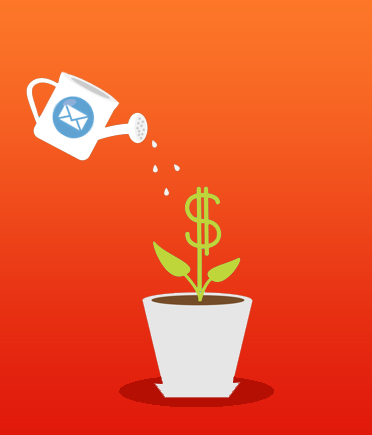Effective Lead Nurturing Strategies You Should Be Following
How effective is your sales funnel?
Are your conversion rates steady and increasing?
Are you able to smoothly transition an unrefined lead into a loyal customer?
If you've answered no the following questions, you're not alone. According to a study from MarketingSherpa, only 36% of marketers execute effective lead nurturing strategies.
That's a large percentage of marketers who either don't know how to properly nurture leads or are trying outdated methods to convert their prospects.

Lead nurturing the very foundation of a business. If you can't nurture your leads, you can't convert them. Further, if you can't convert your leads, you'll lose profit and go out of business.
For-profit organizations, great and small, spend most of their day figuring out ways to woo their prospects over. Though, by following these lead nurturing strategies, you can stay ahead of the pack.
Continue reading to get on board with these fundamental lead nurturing strategies and begin boosting your sales opportunities and profits.
What is Lead Nurturing?
For those that aren't familiar with marketing jargon, a lead is an individual that has an expressed interest in a product or service.
Therefore, lead nurturing is the process of engaging a lead so that they can navigate through a sales funnel.
Every business has its own distinct sales funnel, but the most common aspect of every sales funnel is initial interest and checkout (purchase). Simply speaking, a typical sales funnel refines a lead that's interested in what you have to offer into a customer.
Now, if lead nurturing is this straightforward, why are so many businesses failing at it?
That's primarily because consumers are unpredictable and there are different ways to nurture a lead based on the industry you're in.
But, for the most part, it's very difficult to convince a lead to spend their hard-earned money with your business. That's why lead nurturing exists because you'll have to do all of the dirty work to gradually guide a lead to the point of making a purchase.
In the next section, you will learn how you should specifically guide a lead from a level of interest until they are persuaded to purchase from you.
How Does Lead Nurturing Work?
Nurturing in its purest form means to care for something. For example, if you were tasked with growing a plant, you'll need to guide it from a seed to a fully-grown plant.
Of course, there are steps to nurturing a plant into its final stage. This is true with how leads work. The most common type of sales funnel that relies on the proper nurturing of leads is the "Buyer's Journey".
The Buyer's Journey is a roadmap of the steps a buyer will take to transition from a prospect into a customer. Here are all of the stages of the Buyer's Journey.
- Awareness Stage - In this stage, the buyer has an interest in a product or service. Simply put, he or she is "aware" that they have a need or want that needs to be filled.
- Consideration Stage - In this stage, the buyer has begun to find more information about how they can fill their need or want. The buyer is committed to finding the right solution and will evaluate their options.
- Decision Stage - The buyer has been fully informed of all of their options and will make a decision.
Although the Buyer's Journey is a marketing concept, it's a process everyone uses everyday. Hence, lead nurturing works by guiding leads through each step of the Buyer's Journey, or whatever sales funnel your marketing and sales team uses.
Lead nurturing is difficult because, as mentioned previously, consumers are unpredictable. One day, they may decide to purchase from you, but two weeks later they may forget you even existed.
The purpose of lead nurturing is to convert all leads, both simple and difficult ones. There is no one-size-fits-all approach to nurturing leads, nor is there is any universal method.
If your business is struggling to properly convert leads, you could be suffering from these issues.
- You don't have comprehensive information and data about your target audience.
- You give up too quickly on leads.
- You aren't following up with your leads in the right way.
- You aren't keeping your leads engaged.
- You're not giving your leads enough information about your business.
- You're not giving your leads what they want.
As you can see, there are a wide variety of reasons why your lead nurturing strategies aren't working. To get your business back on track with converting leads successfully, continue to the next section to learn more about what you shouldn't do concerning lead nurturing.
Avoid These Lead Nurturing Mistakes
Converting a lead is a delicate process that many businesses get wrong, time and time again. Overall, here are some lead nurturing mistakes you should stay away from.
- Giving Up Prematurely - Just because someone expressed interest in your business and hasn't called you back in a month doesn't mean they aren't still interested. Giving up on quality lead because of impatience is a great way to miss out on wide-open sales opportunities.
- Skipping Right to the Purchase - Everyone is familiar with the approach salespeople use to sell products and services. These individuals have built a notorious reputation over the years for trying to make people commit to items they knew nothing about. Don't fall into this same trap by skipping right to the purchase instead of providing your leads with information.
- Using Jargon - Converting leads is a sales-related job. However, you should never talk like a salesperson while interacting with prospects. Not only do consumers rarely understand jargon, but talking in circles around a prospect could confuse them and make them think twice about doing business with you.
Avoiding these mistakes can make the difference in practicing effective lead nurturing techniques. Speaking of which, it's time to present a list of important lead nurturing strategies you should implement.
Lead Nurturing Strategy #1: Create Targeted Content
Content is king, as many marketers explain. Company blogs, whitepapers, and ebooks do more than making a business look professional and sophisticated.
Businesses use these materials to convert their prospects. Using the example of the Buyer's Journey above, targeted content is essential for guiding leads through your sales funnel.
Let's say that your home was recently burglarized that you need an HD security camera to deter future criminals. You do some digging online to find six competitors offering the same product.
You're going to want to obtain some information about how their products will benefit you and save your money. This is how digital content can accomplish this goal.
- Whitepapers - Whitepapers are more like essays. For technical audiences, these materials can break down a problem, offer a solution (your product), and provide proof why your solution is ideal.
- Case Studies - Case studies are some of the most powerful types of marketing collateral. These studies provide in-depth data about how your product and services benefited a customer.
- eBooks - eBooks teach people how to do certain things. For entrepreneurs and professionals, eBooks are the perfect educational resources.
All of these forms of content work well with moving leads down a sales funnel, but it's important to send targeted content to the right audience.
For example, for leads that provided you their email address for a consultation, send them an email with links to relevant blog posts that will familiarize themselves with your brand.
Sending targeted content is a proven way of converting leads more efficiently. If your business creates powerful content, this task should be relatively simple.
Lead Nurturing Strategy #2: Nurture Your Leads Across Different Channels
Surprisingly, four out of five marketers state that their email open rates do not exceed 20%. If you are like these marketers, then it's time to start thinking beyond the inbox.
Many businesses fail to increase their conversions because they only rely on one marketing channel to do all of the work for them. In reality, all of your marketing channels are supposed to work together to churn more leads and increase profits.
Here is how that is supposed to work.
Your website is your main marketing channel. Before anything else, a prospect will visit their website to interact with you. Many businesses use their website to promote their email list, but they forget about using the same effort to promote their other marketing channels like social media, print media, etc.
This is called multichannel lead nurturing, and it's effective because it builds relationships from all angles of your business. Hence, if your email open rate isn't optimal, you can still build off the leads you receive from your social media accounts.
Furthermore, the purpose of multichannel lead nurturing is to promote every channel simultaneously. For example, if you are running a Facebook promotion, spend that time to promote your email list.
If you have a paid ads campaign in the works, prompt your audience to visit your website where you will promote your social media. The goal here is to make sure each of your marketing channels is feeding off of each other.
Doing so will lead to increased sales opportunities and better-refined leads.
Lead Nurturing Strategy #3: Score Your Leads
Every lead is not the same, and the sooner you understand that the better you can devote your efforts to each individual lead.
Some prospects will immediately seek to do business with you, while others need more time. Because of this, creating a scoring system for your leads that indicate their value.
Sure, all leads are important. But, some are more valuable than others and require more effort. You can set up a lead scoring system in numeric values from 1-5, where 1 indicated interested prospects and 5 indicated prospects who have just agreed to learn more about your business.
Lead Nurturing Strategy #4: Perform Timely Follow-Ups
Time is money.
Literally!
A study from the Harvard Business Review stated that the odds of a lead entering the nurturing process are 21 times greater when they are contacted five minutes after they express interest.
It's obvious to understand why this is true. When a person is interested in a business, that level of interest is still there if they are contacted that same day.
Though, over time, this interest can fade away. Then, it becomes difficult to reignite it. Fortunately, a simple email follow-up or phone call can make the difference whether you receive a qualified lead or not.
The most important part of lead nurturing is to reach back out to your leads if they contact you. This is because you'll likely never get that same opportunity if you wait.
Lead Nurturing Strategy #5: Send Personalized Emails
Inbound marketing is supposed to be personal, and so should your lead nurturing strategies. If you have the same line for everyone who contacts you, your conversion rates will drop significantly.
Consumers want to be sure they are dealing with a genuine business. To show your prospects that they have your attention, take the time to craft personalized emails.
This is how you can get the job done.
If you are running an e-commerce shop, you can create a segmented list for all of the leads that clicked on a particular product. Next, you can prepare a personalized email that reminds them of their interest in that product or that you have a discount code for it.
Doing so is much more effective than sending a mass email that only relates to a few of your email subscribers. Converting leads is also about individual effort, so make time to respond to each lead directly.
Lead Nurturing Strategy #6: Combine Your Sales and Marketing Efforts
Although converting leads is explicitly the job of your sales team, your marketing team should also be involved with the process. This is because your marketing team does all of the work concerning helping your business to receive leads.
This means that they can provide meaningful insights and information to assist your sales team. According to a Sales Performance Optimization Study from 2014, 89% of companies that aligned their sales and marketing efforts to nurture leads reported increased conversion rates.
Lead Nurturing Strategy #7: Set up Automated Email Sequences
Once your business grows, it can be difficult to manually stay on top of your lead nurturing tasks. If your leads begin to fall through the cracks, you could eventually have a serious problem on your hands.
Fortunately, there are plenty of email providers (like FireDrum) that allow users to set up automated email sequences. Automatic email sequences are beneficial because they're prompt, catching leads when their interest level is at its peak.
These sequences are ideal for large businesses that want to automate their lead nurturing processes to make their conversions more efficient.
Lead Nurturing Strategy #8: Retarget Your Leads
One costly mistake some businesses make is sending the same messages to their audience over and over again. If your engagements are particularly low for your marketing initiatives, try setting up a retargeting campaign.
Much like a win-back campaign, a retargeting campaign strives to regain the interest of a cold lead. It's important to remember that your retargeting campaign must be well planned.
This means you must segment your entire prospect list to retarget them in a way that will appeal directly to them. Doing this will increase your likelihood of recapturing cold leads.
Lead Nurturing Strategy #9: Content Personalization
Personalization is often done in emails, but did you know you can do the same thing with your content?
By taking a look at your segmented lists, you can instruct your marketing team to develop content that will answer any questions and concerns. This type of personalized content will improve your conversion rates and be useful in the future for other leads.
Final Words
Lead nurturing is a very important aspect of doing business. Following all of the tips above will put you on the right track to gain and retain critical leads and stay directly ahead of your competition.




